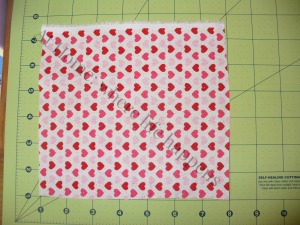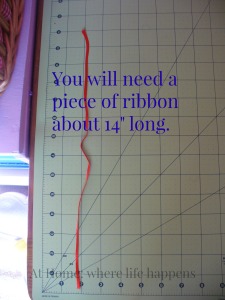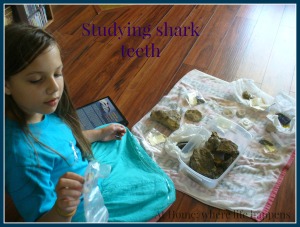
In our house, literature is all around us and everyone in the family constantly has at least one book going. That made Progeny Press appealing to us – study guides for literature from a Christian perspective.

We have been studying two different books using Progeny Press Study Guides – Little House In The Big Woods and The Courage of Sarah Noble. Progeny Press Study Guides have a couple of things in common, even though Little House In The Big Woods E-guide is recommended for use by 4th-6th grade students and The Courage of Sarah Noble E-guide is recommended for use by K-3rd graders. Both of our study guides began with notes to the instructor. Next is a synopsis of the book and information regarding the author of the book. Following the author’s page, we found facts about the time period and the part of the country that the book is set in. Both of our study guides also included some Before-You-Read Activities, which helped set the tone for the book and guide. Another way in which both of our study guides were similar is that the lessons were set up in groups of 2 chapters at a time. These lessons always included a set of vocabulary words and definitions with various activities to engage the student. These lessons also always included a set of questions, though the set up of these was dramatically different between the K-3 study guide and the 4-6 study guide.

Little House In The Big Woods Study Guide
This guide was used by our oldest giggly girl who is 10 years old. I had been wanting to get her started on the Little House books and this was a great opportunity to introduce these wonderful books to her. She read straight through the book when she first got her hands on it. She wasn’t asked to do this but it worked out good, since this is recommended by Progeny Press. (They recommend, at least at this level, that the student read the whole book through first and then go back and work through the questions in two chapter sets.)
We started by having E read the synopsis, the author information, and the background information. We then talked about these things, especially the background information. We completed a couple of the Before-You-Read activities.  She searched on the computer for information on Paul Bunyan and read the story of the lumberjack. We also found a video of the Paul Bunyan story that was entertaining. We also pulled out our big US map (remember the one from our states study?) and found Wisconsin on it. That allowed her to review a bit about what Wisconsin is famous for and words that describe the state. The activity in the study guide asked us to study a map of Wisconsin, so we located one of those (actually found one from the Laura Ingalls Wilder museum) and studied where Pepin was (on the Mississippi) and where the forests of Wisconsin were and are currently.
She searched on the computer for information on Paul Bunyan and read the story of the lumberjack. We also found a video of the Paul Bunyan story that was entertaining. We also pulled out our big US map (remember the one from our states study?) and found Wisconsin on it. That allowed her to review a bit about what Wisconsin is famous for and words that describe the state. The activity in the study guide asked us to study a map of Wisconsin, so we located one of those (actually found one from the Laura Ingalls Wilder museum) and studied where Pepin was (on the Mississippi) and where the forests of Wisconsin were and are currently.
Then we jumped into the lessons. Each lesson began with a vocabulary activity, focusing on 5 to 10 words and their definitions within the context of the story. Most of these words are ones that I would have chosen myself because they are used differently or not at all in our society or lifestyle. Some examples of words include kegs (for a barrel to hold items in), sullen, sulked, bored (with a knife), and flatirons. The activities varied from lesson to lesson. In some the word was given and the student was asked to consult a dictionary and write the definition. In another, the student was given a short definition and had to unscramble the letters to find the word. In yet another, the student was given multiple-choice answers to choose from. This variation helped to keep the interest in a task that can be dull and boring.

In the questions for Little House In The Big Woods, there are two sections. One is titled Questions. The other is titled Digging Deeper. The Questions section is lower level thinking (information and comprehension levels of Bloom’s taxonomy). These are questions that ask you to repeat information from the book, such as “Where were Laura and Mary’s playhouses?” These were very easy, and therefore actually frustrating for E. She did not want to answer these! She was required to answer a few out of each lesson, but we did not require her to answer all of them because they didn’t really add much to her learning. We spent a lot more time on the Digging Deeper section. These questions focus on the higher level thinking (application, analysis, synthesis, evaluation) and are the types of questions that really grabbed E’s attention. She was required to answer almost all of the questions in this section each time. One thing I liked about this section is the questions were quite different – Bible application, social settings, comparing your life to theirs, and so much more. These are the questions that really create a learning situation for E. An example of questions from this section – “What does each child receive for Christmas? How does this compare to what you normally receive for Christmas? Would you be happy with (what they received)? Why or why not?” These push her beyond simply knowing the answer. These make her think and defend her position.

After the Digging Deeper section, the Little House study guide then gave suggestions for activities that help foster further learning and investigation. We did at least one of these from each of the lessons. For one E made Hasty Pudding. This is cornmeal pudding, not sweet, but very good with a drizzle of honey over it. It surprised us and allowed us to talk about the use of sugar during Laura’s time. Another activity that she did was carve soap. Pa whittled and carved in the book and this activity allowed her to feel what it was like to carve and create. There are 3-4 activities for each lesson and this was our favorite part of each lesson.

The study guide finishes up with a crossword puzzle to print and complete. It also has some activities to wrap-up the whole book, including some presentation ideas. We did not make it to this point, honestly. There is so much to these study guides and the activities that we just did not have time to get there, since we had some illness occur during this period. But we made it about 90% of the way through the guide and we will finish it out.

One way in which this study guide is different from The Courage of Sarah Noble is that it is an interactive PDF file that you download. You can print out the PDF and the student can write all of her answers on the page. We did this and it worked well. It is also set up so that the student can use the PDF file on the computer and type in her answers. We did this, as well, to see what it was like. This has some definite advantages – you don’t have to print it out and use paper and ink; sometimes typing answers helps the student to be more interested; it can be saved as a PDF file and easily added to portfolios. E liked it both ways and she didn’t have a preference of one way over the other. Personally, I liked that printed out, she did not have to be locked in at a computer. She could take it to the couch, her room, or a table. It is more flexible when printed out, in my opinion.

The Courage of Sarah Noble
This study guide was used by our middle giggly girl who is 8. She absolutely loved the book. She also read through it all the way the first time she got her hands on it. Again, this is encouraged by Progeny Press. In my opinion, it helps the student get the big picture of the book and be able to put a lot of it in context when it comes to answering questions.
I do not think this study guide is as good as the other one we were asked to review. It is for a lower age level but it actually has significantly less hands-on activities, which is more important for K-3rd students.
 After reading the synopsis, author information, and background information with L, we jumped into the Before-You-Read activities. We pulled out a US map and looked at Connecticut. We talked about what we knew about Connecticut and what the wilderness would be like in the 1700s. We answered some of the questions from this section including things like what it would be like to knock on a stranger’s door to ask for shelter for the night. These were good activities to get her mind set on how things were back then as compared to what she knows.
After reading the synopsis, author information, and background information with L, we jumped into the Before-You-Read activities. We pulled out a US map and looked at Connecticut. We talked about what we knew about Connecticut and what the wilderness would be like in the 1700s. We answered some of the questions from this section including things like what it would be like to knock on a stranger’s door to ask for shelter for the night. These were good activities to get her mind set on how things were back then as compared to what she knows.
This study guide had an activity that the other did not. It included an As-You-Read Activity. It asked the reader to keep a list all the times Sarah Noble reminded herself to keep up her courage. L kept a list of the times she reminded herself with words and a separate list of when she reminded herself with her cloak. This was an interesting comparison and really brought out how often we all need reminded to keep up our courage in difficult situations.
As with the Little House study guide, each lesson covered two chapters and began with vocabulary work. There were between 5 and 10 words for each lesson. The vocabulary activities varied from looking it up in a dictionary and writing the definition to matching a word to its definition. The words chosen often represented words that we don’t often encounter such as palisade, namesake, and musket. They are great words and, again, are the kinds of words I would have chosen myself.

The Questions section was structured differently, as well. It only had one section of questions. This section included questions from all thinking levels. There were informational level questions next to analysis questions and evaluation questions next to comprehension questions. This was interesting in that it kept her thinking with different processes throughout. She did not like answering the questions at all but it wasn’t because the questions were not good; I don’t know why it didn’t fit her well. Some examples of questions include “Why do you think Tall John was looking sadly at her?” and “What did her father tell her was the best courage of all?” One part of the questions section that I really liked was that it included some application of Bible verses. Since this is an area our family focuses on, I like that this was included for each chapter.

The Sarah Noble study guide ended with three hands-on learning activities. Activities like these are good but I wish there had been activities like this for each lesson, not just at the end. It would have improved this greatly and perhaps L would have enjoyed it more. L created a log cabin out of pretzels and icing. It was a great learning activity because she realized just how much thought and work has to go into building a house from logs, how many problems can occur. For art, she is going to create a collage of Sarah and her father in the woods. There is also a pebble game similar to that which the Indians might have played with Sarah. This activity actually held no appeal for L so we skipped it.
Buying a Progeny Press Study Guide
To purchase a Progeny Press study guide, visit their website at http://ProgenyPress.com. Their website is easy to navigate and you can easily find what you are looking for. The study guides we used were both digital downloads. Little House In The Big Woods is priced at $16.99 and is an interactive download. The Courage of Sarah Noble is priced at $11.99 and is not interactive. Once you have purchased these, you can download and save the file to your computer. You then print what you need/want or open the file for the interactive PDF, type in your answers, and save it to your computer. If you have any questions, their FAQ is easy to read and gives a lot of information.
Things To Note
* I did not like that the lessons were done in two chapter sets, with no indication of where question answers could be found. This was especially frustrating, in both study guides, with the vocabulary. Since these were set in the 1700s and 1800s, some of the word usage is different and it was not always easy for the girls to accurately define the words the way the books used them. When they had to look for the words in the books to help them out, especially in the Little House book, it could be 40 pages to look through. It was time consuming and frustrating. With the Little House book, the download did include an answer key. That gave the answer but did not give any indication of where the student could locate the information to help them formulate the answer. (As a side note – I do realize that they cannot give page numbers since each printing of a book will end up with different page numbers. Keeping the lesson to one chapter would certainly help this, though.)
* I say this often but I will say it again: pick and choose to fit your student and your family. These study guides have a lot in them! The oldest giggly girl, E, did not enjoy or need the lowest level thinking questions, meaning those where you are just repeating information from the book. We did not complete every single question. However, in the Digging Deeper section of the Little House study guide, she had to think and apply the information, compare information, or use the ideas from the book in a different way. We did a lot more work in this section because it was more interesting to her and she got a lot out of it.
* These guides are more of a worksheet learning style. I think the guides for K-3 would benefit from a lot more activities and fewer questions. These would fit a family whose learning style is question/answer or a family whose students are older (middle-school/high school).
Final Thoughts
At this time, we are not planning on purchasing more of these study guides. They really do not fit our family’s style of learning. I can see that these will be very good for older students and I do foresee us purchasing from this company when the girls are older. At Home.
To see more reviews on these study guides or study guides for different literature selections from Progeny Press, click on the banner below.


Share At Home: where life happens













 but not much. So, she began in the Bravo class with other beginners. At semester, they determined that she had made so much progress and was playing well enough to jump up a year and join the Encore class. Now that was huge and she had a big learning curve since they all had a year more experience than she did. But she undertook the challenge, practiced daily, and did really well.
but not much. So, she began in the Bravo class with other beginners. At semester, they determined that she had made so much progress and was playing well enough to jump up a year and join the Encore class. Now that was huge and she had a big learning curve since they all had a year more experience than she did. But she undertook the challenge, practiced daily, and did really well.





















































